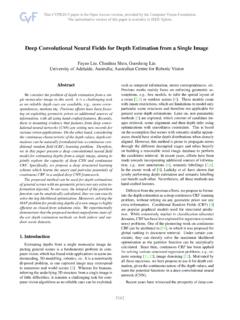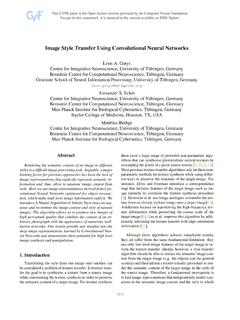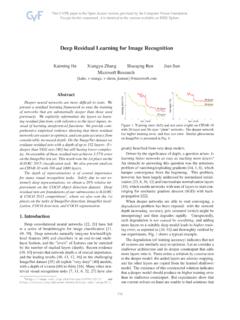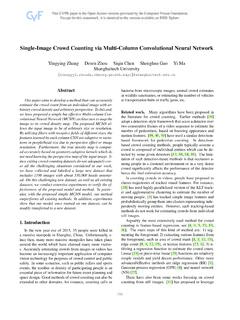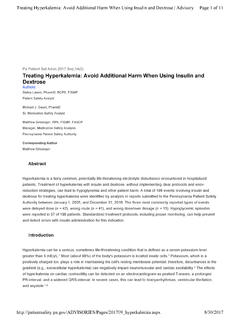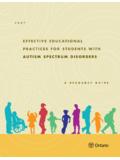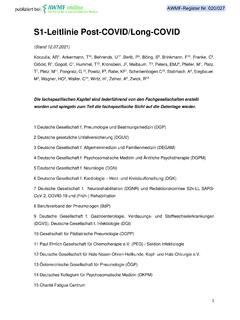Transcription of Fast R-CNN
1 Fast R-CNNRoss GirshickMicrosoft paper proposes a Fast Region-based ConvolutionalNetwork method(Fast R-CNN )for object detection. FastR-CNN builds on previous work to efficiently classify ob-ject proposals using deep convolutional networks. Com-pared to previous work, Fast R-CNN employs several in-novations to improve training and testing speed while alsoincreasing detection accuracy. Fast R-CNN trains the verydeep VGG16 network 9 faster than R-CNN , is 213 fasterat test-time, and achieves a higher mAP on PASCAL VOC2012. Compared to SPPnet, Fast R-CNN trains VGG16 3 faster, tests 10 faster, and is more accurate.
2 Fast R-CNNis implemented in Python and C++ (using Caffe) and isavailable under the open-source MIT License IntroductionRecently, deep ConvNets [14,16] have significantly im-proved image classification [14] and object detection [9,19]accuracy. Compared to image classification, object detec-tion is a more challenging task that requires more com-plex methods to solve. Due to this complexity, current ap-proaches ( , [9,11,19,25]) train models in multi-stagepipelines that are slow and arises because detection requires the ac-curate localization of objects, creating two primary chal-lenges.
3 First, numerous candidate object locations (oftencalled proposals ) must be processed. Second, these can-didates provide only rough localization that must be refinedto achieve precise localization. Solutions to these problemsoften compromise speed, accuracy, or this paper, we streamline the training process for state-of-the-art ConvNet-based object detectors [9,11]. We pro-pose a single-stage training algorithm that jointly learns toclassify object proposals and refine their spatial resulting method can train a very deep detectionnetwork (VGG16 [20]) 9 faster than R-CNN [9] and 3 faster than SPPnet [11].
4 At runtime, the detection networkprocesses images in (excluding object proposal time)while achieving top accuracy on PASCAL VOC 2012 [7]with a mAP of 66% (vs. 62% for R-CNN ). R-CNN and SPPnetThe Region-based Convolutional Network method ( R-CNN ) [9] achieves excellent object detection accuracy byusing a deep ConvNet to classify object proposals. R-CNN ,however, has notable is a multi-stage first fine-tunes a ConvNet on object proposals using log , it fits SVMs to ConvNet features. These SVMsact as object detectors, replacing the softmax classi-fier learnt by fine-tuning. In the third training stage,bounding-box regressors are is expensive in space and SVMand bounding-box regressor training, features are ex-tracted from each object proposal in each image andwritten to disk.
5 With very deep networks, such asVGG16, this process takes GPU-days for the 5kimages of the VOC07 trainval set. These features re-quire hundreds of gigabytes of detection is test-time, features areextracted from each object proposal in each test with VGG16 takes 47s / image (on a GPU). R-CNN is slow because it performs a ConvNet forwardpass for each object proposal, without sharing pyramid pooling networks (SPPnets) [11] were pro-posed to speed up R-CNN by sharing computation. TheSPPnet method computes a convolutional feature map forthe entire input image and then classifies each object pro-posal using a feature vector extracted from the shared fea-ture map.
6 Features are extracted for a proposal by max-pooling the portion of the feature map inside the proposalinto a fixed-size output ( ,6 6). Multiple output sizesare pooled and then concatenated as in spatial pyramid pool-ing [15]. SPPnet accelerates R-CNN by 10 to 100 at testtime. Training time is also reduced by 3 due to faster pro-posal feature timings use one Nvidia K40 GPU overclocked to 875 also has notable drawbacks. Like R-CNN , train-ing is a multi-stage pipeline that involves extracting fea-tures, fine-tuning a network with log loss, training SVMs,and finally fitting bounding-box regressors.
7 Features arealso written to disk. But unlike R-CNN , the fine-tuning al-gorithm proposed in [11] cannot update the convolutionallayers that precede the spatial pyramid pooling. Unsurpris-ingly, this limitation (fixed convolutional layers) limits theaccuracy of very deep ContributionsWe propose a new training algorithm that fixes the disad-vantages of R-CNN and SPPnet, while improving on theirspeed and accuracy. We call this methodFast R-CNNbe-cause it s comparatively fast to train and test. The Fast R-CNN method has several advantages:1. Higher detection quality (mAP) than R-CNN , SPPnet2.
8 Training is single-stage, using a multi-task loss3. Training can update all network layers4. No disk storage is required for feature cachingFast R-CNN is written in Python and C++ (Caffe[13]) and is available under the open-source MIT Li-cense Fast R-CNN architecture and the Fast R-CNN architecture. A FastR-CNN network takes as input an entire image and a setof object proposals. The network first processes the wholeimage with several convolutional (conv) and max poolinglayers to produce a conv feature map. Then, for each ob-ject proposal a region of interest (RoI) pooling layer ex-tracts a fixed-length feature vector from the feature feature vector is fed into a sequence of fully connected(fc) layers that finally branch into two sibling output lay-ers: one that produces softmax probability estimates overKobject classes plus a catch-all background class andanother layer that outputs four real-valued numbers for eachof theKobject classes.
9 Each set of4values encodes refinedbounding-box positions for one of The RoI pooling layerThe RoI pooling layer uses max pooling to convert thefeatures inside any valid region of interest into a small fea-ture map with a fixed spatial extent ofH W( ,7 7),whereHandWare layer hyper -parameters that are inde-pendent of any particular RoI. In this paper, an RoI is arectangular window into a conv feature map. Each RoI isdefined by a four-tuple(r, c, h, w)that specifies its top-leftcorner(r, c)and its height and width(h, w).DeepConvNetConvfeature mapRoIprojectionRoIpoolinglayerFCsRoI featurevectorsoftmaxbboxregressorOutputs :FCFCFor each RoIFigure 1.
10 Fast R-CNN architecture. An input image and multi-ple regions of interest (RoIs) are input into a fully convolutionalnetwork. Each RoI is pooled into a fixed-size feature map andthen mapped to a feature vector by fully connected layers (FCs).The network has two output vectors per RoI: softmax probabilitiesand per-class bounding-box regression offsets. The architecture istrained end-to-end with a multi-task max pooling works by dividing theh wRoI win-dow into anH Wgrid of sub-windows of approximatesizeh/H w/Wand then max-pooling the values in eachsub-window into the corresponding output grid cell.


